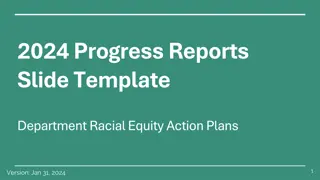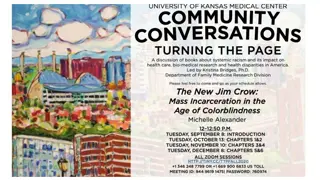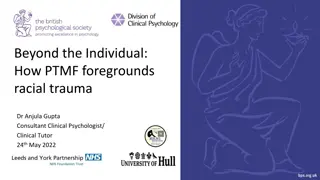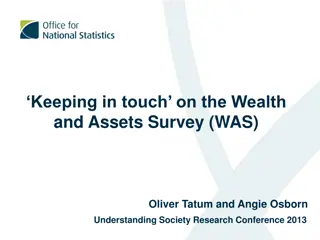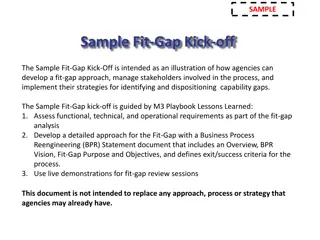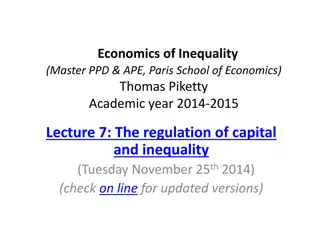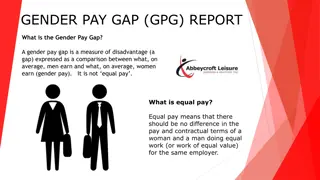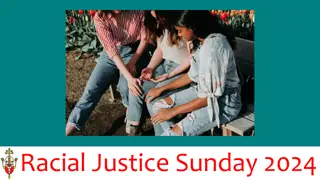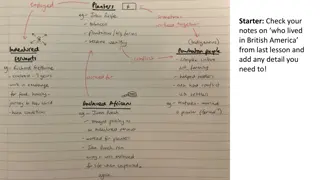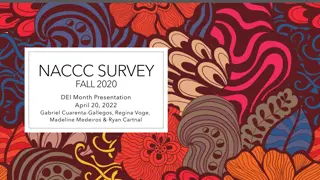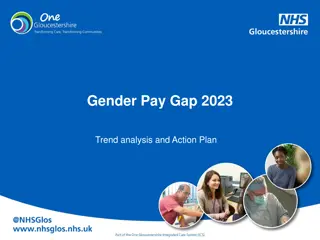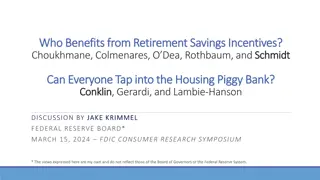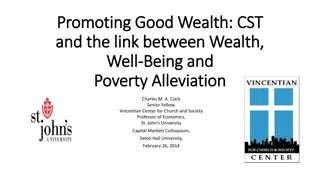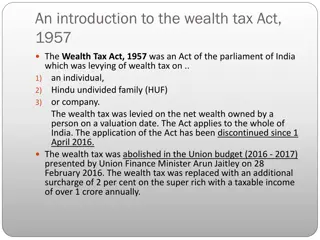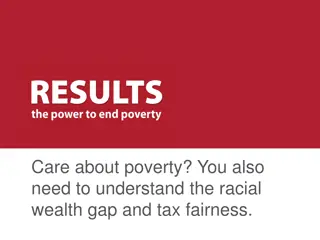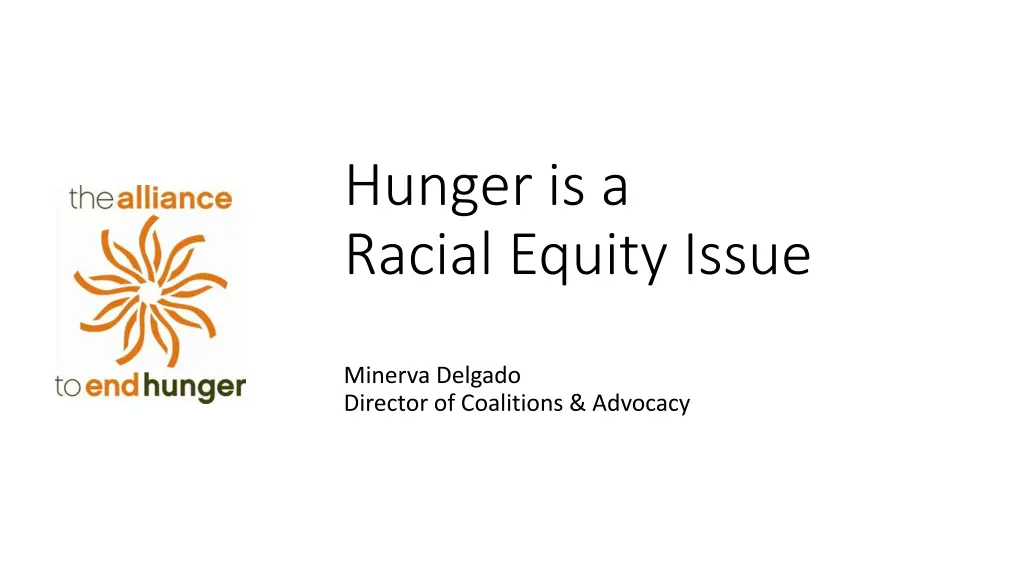
Addressing Hunger Disparities and Racial Equity: Alliance Initiatives
Explore the initiatives of the Alliance to End Hunger in tackling hunger disparities through racial equity, including a virtual simulation highlighting policies such as land seizures and their impact on communities of color. Join the movement to advocate for change and end hunger worldwide.
Uploaded on | 0 Views
Download Presentation

Please find below an Image/Link to download the presentation.
The content on the website is provided AS IS for your information and personal use only. It may not be sold, licensed, or shared on other websites without obtaining consent from the author. If you encounter any issues during the download, it is possible that the publisher has removed the file from their server.
You are allowed to download the files provided on this website for personal or commercial use, subject to the condition that they are used lawfully. All files are the property of their respective owners.
The content on the website is provided AS IS for your information and personal use only. It may not be sold, licensed, or shared on other websites without obtaining consent from the author.
E N D
Presentation Transcript
Hunger is a Racial Equity Issue Minerva Delgado Director of Coalitions & Advocacy
Alliance to End Hunger The Alliance to End Hunger engages diverse institutions to build the public and political will to end hunger at home and abroad. The Alliance to End Hunger is a membership organization of over 100 national nonprofits, international nonprofits, businesses, universities and foundations. www.alliancetoendhunger.org
Racial Wealth Gap Learning Simulation
Instructions for Virtual Simulation We will start off in a larger group to read the policy cards. Some of the participants will have a white participant race card and some of the participants will have a Black participant race card. There are three action cards ( money, land, and opportunity lost ) and thirteen policy cards. The facilitator will invite people to read a policy card aloud. Then, the facilitator will read the action(s) on the card for participants to carry out. There will be a slight pause so that everyone can review the actions as they are carried out virtually on the shared screen. Everyone will add or subtract one, two, or all three cards in each round. At the end, we will count how many money, land, & opportunity lost cards everyone has! After, the facilitator will separate the group into smaller groups by using virtual breakout rooms. After, small groups will share with the larger group and conclude the simulation discussion.
Policy # 1 Land Seizures (1865-Present Day)
Policy #1 Andrew Johnsons Land Policies and Sharecropping After the Civil War, only 30,000 African Americans owned small plots of land, compared to 4 million who did not because an 1865 federal law rescinded the government s promise of 40 acres of land for former slaves. These 4 million blacks largely resorted to renting the farm land of their previous master in exchange for a share of their crop. This system of sharecropping tied farmers to their former master because they were legally obligatedto BUY all farming materials (usually at higher prices) and SELL their farming crops solely totheir former master (usually at lowerprices). ACTION Black participants Add one land card and one money card to represent the lessthan 1 percent of African Americans who were able to own land and not face debt after slavery. Unfortunately, Black participants should also add four lost opportunity cards for the 4 million African Americans who had to sharecrop and were denied the initial promise of land ownership. Buying farm supplies from the landowner at higher prices, only to sell their crops back at lower prices, resulted in African Americans facing higher levels of debt and higher rates ofhunger.
Policy #1 Andrew Johnsons Land Policies and Sharecropping After the Civil War, only 30,000 African Americans owned small plots of land, compared to 4 million who did not because an 1865 federal law rescinded the government s promise of 40 acres of land for former slaves. These 4 million blacks largely resorted to renting the farm land of their previous master in exchange for a share of their crop. This system of sharecropping tied farmers to their former master because they were legally obligatedto BUY all farming materials (usually at higher prices) and SELL their farming crops solely totheir former master (usually at lowerprices). ACTION Black participants Add one land card and one money card to represent the lessthan 1 percent of African Americans who were able to own land and not face debt after slavery. Unfortunately, Black participants should also add four lost opportunity cards for the 4 million African Americans who had to sharecrop and were denied the initial promise of land ownership. Buying farm supplies from the landowner at higher prices, only to sell their crops back at lower prices, resulted in African Americans facing higher levels of debt and higher rates ofhunger.
Black Participants White Participants
Policy # 2 Andrew Johnson s Land Policies and Sharecropping (1865-1880)
Policy #2 Land Seizures From 1865 on, Blacks could have their land seized to pay sharecropping debts or simply because white landowners declared that Black farmers or businesses were in debt. Blacks could not fight these charges because they were legally prohibited from suing whites in court. In addition, from 1949-1970, one million people lost their land to abuses of the power of eminent domain, which allows local governments to seize private property. About 70 percent of these families were African American. ACTION White participants Add one land card and two money cards for having the legal ability to seize the land of black farmers and business owners, increasing your income and reducing your vulnerability to hunger. Black participants Subtract a land card for the land lost under land seizures. Also subtract a money card for the tens of millions of dollars lost from no longer having land to help earn an income and grow food to eat.
Policy #2 Land Seizures From 1865 on, Blacks could have their land seized to pay sharecropping debts or simply because white landowners declared that Black farmers or businesses were in debt. Blacks could not fight these charges because they were legally prohibited from suing whites in court. In addition, from 1949-1970, one million people lost their land to abuses of the power of eminent domain, which allows local governments to seize private property. About 70 percent of these families were African American. ACTION White participants Add one land card and two money cards for having the legal ability to seize the land of black farmers and business owners, increasing your income and reducing your vulnerability to hunger. Black participants Subtract a land card for the land lost under land seizures. Also subtract a money card for the tens of millions of dollars lost from no longer having land to help earn an income and grow food to eat.
Black Participants White Participants
Policy # 3 The National Housing Act of 1934, Part 1
Policy #3 The National Housing Act of 1934, Part 1 Policies under this law guaranteed federally-backed loans to whites and legally refused loans to blacks and anyone else who chose to live in or near Black neighborhoods. This practice, known as redlining, targeted entire Black neighborhoods and identified them as Grade D. This made it nearly impossible for appraisers in the private sector to do business in Black neighborhoods because all the residents were considered bad credit risks. ACTION White participants Add one land card and one money card for the equity gained in purchasing homes not near black neighborhoods. Equity increased a family s ability to save for future needs. Black participants Do not add any land cards because of the inability to purchase homes. Do not add any money cards since it was illegal to lend to Blacks, preventing them from building equity and weakening their ability to save for future needs.
Policy #3 The National Housing Act of 1934, Part 1 Policies under this law guaranteed federally-backed loans to whites and legally refused loans to blacks and anyone else who chose to live in or near Black neighborhoods. This practice, known as redlining, targeted entire Black neighborhoods and identified them as Grade D. This made it nearly impossible for appraisers in the private sector to do business in Black neighborhoods because all the residents were considered bad credit risks. ACTION White participants Add one land card and one money card for the equity gained in purchasing homes not near black neighborhoods. Equity increased a family s ability to save for future needs. Black participants Do not add any land cards because of the inability to purchase homes. Do not add any money cards since it was illegal to lend to Blacks, preventing them from building equity and weakening their ability to save for future needs.
Black Participants White Participants
Policy # 4 The National Housing Act of 1934, Part 2
Policy #4 The National Housing Act of 1934, Part 2 Since this legislation prevented blacks from receiving federally-backed home mortgages, whites usually purchased homes in black neighborhoods and then sold housing contracts to blacks who wanted to become homeowners, often for two or three times the amount of the mortgage. These contracts only guaranteed black families the rights to the house AFTER all the payments were complete. Missing even one payment, or being late, would result in the black family losing their house immediately. ACTION White participants Add two land cards for being able to legally purchase homes at the market rate, and pick up two money cards for the equity earned from homeownership. Black participants Add one land card for signing a contract for a home in hopes of becoming a homeowner one day. Do not add any money cards because contracts stripped additional income and wealth from several generations. Also add one lost opportunity card because of the higher interest paid and less equity earned once the home was actually purchased.
Policy #4 The National Housing Act of 1934, Part 2 Since this legislation prevented blacks from receiving federally-backed home mortgages, whites usually purchased homes in black neighborhoods and then sold housing contracts to blacks who wanted to become homeowners, often for two or three times the amount of the mortgage. These contracts only guaranteed black families the rights to the house AFTER all the payments were complete. Missing even one payment, or being late, would result in the black family losing their house immediately. ACTION White participants Add two land cards for being able to legally purchase homes at the market rate, and pick up two money cards for the equity earned from homeownership. Black participants Add one land card for signing a contract for a home in hopes of becoming a homeowner one day. Do not add any money cards because contracts stripped additional income and wealth from several generations. Also add one lost opportunity card because of the higher interest paid and less equity earned once the home was actually purchased.
Black Participants White Participants
Policy # 5 The Social Security Act (1935)
Policy #5 The Social Security Act This act excluded farmworkers and domestic workers, who were predominantly Black, from receiving old age and unemployment insurance. Although Social Security was meant to help those affected by the Great Depression, and African Americans were twice as likely as the average American family to face hunger during this time, 65 percent of African Americans were ineligible to receive Social Security. ACTION White participants Add one money card for being able to benefit from unemployment and old age insurance during a very grim time in American history. Black participants Add one lost opportunity card for the inability to benefit from unemployment insurance even though African Americans were between two and three times as likely as whites to experience poverty and hunger.
Policy #5 The Social Security Act This act excluded farmworkers and domestic workers, who were predominantly Black, from receiving old age and unemployment insurance. Although Social Security was meant to help those affected by the Great Depression, and African Americans were twice as likely as the average American family to face hunger during this time, 65 percent of African Americans were ineligible to receive Social Security. ACTION White participants Add one money card for being able to benefit from unemployment and old age insurance during a very grim time in American history. Black participants Add one lost opportunity card for the inability to benefit from unemployment insurance even though African Americans were between two and three times as likely as whites to experience poverty and hunger.
Black Participants White Participants
Policy # 6 The Fair Labor Standards Act of 1938
Policy #6 The Fair Labor Standards Act of 1938 This was enacted to help bolster the economy and get the country out of the Great Depression, but it excluded tip-based jobs and other jobs predominantly held by Black workers including servers, shoe shiners, domestic workers, and Pullman porters from this first-ever minimum wage legislation. Even though the Black unemployment, hunger, and poverty rates were at least twice those of whites during the Great Depression, the very policies meant to alleviate economic strain were withheld from the Black community. ACTION White participants Add one money card for benefiting from the minimum wage to make their families less susceptible to hunger and poverty. Black participants Add one lost opportunity card for being stuck in tip-based occupations that did not offer a minimum wage to help families survive during the Great Depression. This made it even harder for them to get back on their feet and build for the future.
Policy #6 The Fair Labor Standards Act of 1938 This was enacted to help bolster the economy and get the country out of the Great Depression, but it excluded tip-based jobs and other jobs predominantly held by Black workers including servers, shoe shiners, domestic workers, and Pullman porters from this first-ever minimum wage legislation. Even though the Black unemployment, hunger, and poverty rates were at least twice those of whites during the Great Depression, the very policies meant to alleviate economic strain were withheld from the Black community. ACTION White participants Add one money card for benefiting from the minimum wage to make their families less susceptible to hunger and poverty. Black participants Add one lost opportunity card for being stuck in tip-based occupations that did not offer a minimum wage to help families survive during the Great Depression. This made it even harder for them to get back on their feet and build for the future.
Black Participants White Participants
Policy # 7 The G.I. Bill of 1944
Policy #7 The G. I. Bill of 1944 This was enacted to help World War II veterans adjust to civilian life by providing low-cost home mortgages, low-interest business loans, tuition assistance, and unemployment insurance. Unfortunately, Black veterans were excluded from many of these benefits. ACTION White participants Add two money cards and one land card for the opportunities you received, such as government-guaranteed housing loans, which helped to build the American middleclass. Black participants Only one Black participant adds a money card, representing the few African Americans who had access to some benefits of the GI Bill. All Black participants add one lost opportunity card for not being able to benefit from the GI Bill even though they too had fought for the United States in World War II.
Policy #7 The G. I. Bill of 1944 This was enacted to help World War II veterans adjust to civilian life by providing low-cost home mortgages, low-interest business loans, tuition assistance, and unemployment insurance. Unfortunately, Black veterans were excluded from many of these benefits. ACTION White participants Add two money cards and one land card for the opportunities you received, such as government-guaranteed housing loans, which helped to build the American middleclass. Black participants Only one Black participant adds a money card, representing the few African Americans who had access to some benefits of the GI Bill. All Black participants add one lost opportunity card for not being able to benefit from the GI Bill even though they too had fought for the United States in World War II.
Black Participants (Only one participant) White Participants
Policy # 8 Overturn of Separate but Equal Doctrine (1954 to Present Day)
Policy #8 Overturn of Separate but Equal Doctrine Although the Separate but Equal Doctrine was declared unconstitutional in 1954 (Brown vs. Board of Education), American schools are more racially segregated today than at any other time in the past four decades. Academic success is less likely in predominately low-income Black neighborhoods. Black students are five times as likely to live in an area of concentrated poverty, with underfunded, understaffed, and overcrowded schools. This leaves Black students with limited education, and many often settle for minimum-wage jobs that offer little hope of advancement or better pay. ACTION White participants Add two money cards for having up to $733 higher annual per-student spending on education than Black students. This contributes to a greater likelihood of attending college and later getting a higher-paying job. Black participants Add only one money card to represent the 75 percent high school graduation rate among African American students, compared to 88 percent among white students. Also pick up one lost opportunity card for the lower student spending that helps funnel many Black students into low-wage work after high school.
Policy #8 Overturn of Separate but Equal Doctrine Although the Separate but Equal Doctrine was declared unconstitutional in 1954 (Brown vs. Board of Education), American schools are more racially segregated today than at any other time in the past four decades. Academic success is less likely in predominately low-income Black neighborhoods. Black students are five times as likely to live in an area of concentrated poverty, with underfunded, understaffed, and overcrowded schools. This leaves Black students with limited education, and many often settle for minimum-wage jobs that offer little hope of advancement or better pay. ACTION White participants Add two money cards for having up to $733 higher annual per-student spending on education than Black students. This contributes to a greater likelihood of attending college and later getting a higher-paying job. Black participants Add only one money card to represent the 75 percent high school graduation rate among African American students, compared to 88 percent among white students. Also pick up one lost opportunity card for the lower student spending that helps funnel many Black students into low-wage work after high school.
Black Participants (Only one participant) White Participants
Policy # 9 Subprime Loans (1970s to Present Day)
Policy #9 Subprime Loans Starting in the 1970s and continuing today, the private sector issued subprime loans (loans with higher interest rates) to Black families almost exclusively regardless of a family s income, education, or good credit history. As a result, Blacks continue to unfairly pay more for homes of the same value as their white counterparts. This increases foreclosure rates among Blacks, which also contributes to higher food insecurity levels. ACTION White participants Add two land cards and two money cards for securing good interest rates on homes. Black participants Blacks were forced into subprime mortgages as their only option for more than three generations stripping income and wealth from the Black community. High-income Blacks were 80 percent more likely to lose their homes than high-income whites when the housing bubble burst in 2008, and 240,000 Blacks lost their homes. Therefore, Black participants add only one land card and one money card.
Policy #9 Subprime Loans Starting in the 1970s and continuing today, the private sector issued subprime loans (loans with higher interest rates) to Black families almost exclusively regardless of a family s income, education, or good credit history. As a result, Blacks continue to unfairly pay more for homes of the same value as their white counterparts. This increases foreclosure rates among Blacks, which also contributes to higher food insecurity levels. ACTION White participants Add two land cards and two money cards for securing good interest rates on homes. Black participants Blacks were forced into subprime mortgages as their only option for more than three generations stripping income and wealth from the Black community. High-income Blacks were 80 percent more likely to lose their homes than high-income whites when the housing bubble burst in 2008, and 240,000 Blacks lost their homes. Therefore, Black participants add only one land card and one money card.
Black Participants (Only one participant) White Participants
Policy # 1 0 The War on Drugs (1971 to Present Day)
Policy #10 The War on Drugs The War on Drugs, initiated in 1971 and continuing today, widened the racial wealth gap with policies targeting Black and Brown communities. Although rates of using and selling drugs are comparable across racial lines, Blacks are up to 10 times as likely to be stopped, searched, arrested, prosecuted, convicted, and/or incarcerated for drug violations as whites. Since this means that Black families are up to 10 times as likely to have a family member sent to prison, they are more than 10 times as likely to fall into hunger because of incarceration. ACTION White participants Subtract two money cards for the more than $180 billion in tax dollars that it costs to maintain mass incarceration today. Also add one lost opportunity card since these taxpayer dollars could instead be used to support programs that end hunger and poverty in the United States. Black participants Combined, debt and property depreciation increase hunger and poverty rates within the Black community. Subtract two money cards for being more likely to be incarcerated than whites and owing debts of about $13,000 per household in fees and court costs when a family member is incarcerated. Subtract one land card for the estimated $11 billion in lower property values in many African American communities caused by the return of large numbers of people from jail or prison.
Policy #10 The War on Drugs The War on Drugs, initiated in 1971 and continuing today, widened the racial wealth gap with policies targeting Black and Brown communities. Although rates of using and selling drugs are comparable across racial lines, Blacks are up to 10 times as likely to be stopped, searched, arrested, prosecuted, convicted, and/or incarcerated for drug violations as whites. Since this means that Black families are up to 10 times as likely to have a family member sent to prison, they are more than 10 times as likely to fall into hunger because of incarceration. ACTION White participants Subtract two money cards for the more than $180 billion in tax dollars that it costs to maintain mass incarceration today. Also add one lost opportunity card since these taxpayer dollars could instead be used to support programs that end hunger and poverty in the United States. Black participants Combined, debt and property depreciation increase hunger and poverty rates within the Black community. Subtract two money cards for being more likely to be incarcerated than whites and owing debts of about $13,000 per household in fees and court costs when a family member is incarcerated. Subtract one land card for the estimated $11 billion in lower property values in many African American communities caused by the return of large numbers of people from jail or prison.
Black Participants (Only one participant) White Participants
Policy # 1 1 Life After Incarceration Consequences of the War on Drugs (Present Day)
Policy #11 Life After IncarcerationConsequences of the War on Drugs When people are released from jail or prison, they are hoping for a second chance. But they face more than 48,000 separate restrictions, known as collateral consequences. Some examples of lifelong penalties include being denied the right to vote in some states, being prohibited from applying to higher-paying jobs, being ineligible to participate in social safety net programs such as SNAP (the Supplemental Nutrition Assistance Program, formerly food stamps), and other restrictions, such as being banned from getting a barber s license. Since Blacks are up to 10 times as likely as whites to be stopped, arrested, and sentenced, they are also up to 10 times as likely to face these restrictions. ACTION Black participants There are five times as many Blacks as whites returning home with criminal records. Add two lost opportunity cards to represent how Black communities are more likely to fall into hunger because so many returnees are unable to reintegrate into society, get a job, and/or access SNAP benefits.
Policy #11 Life After IncarcerationConsequences of the War on Drugs When people are released from jail or prison, they are hoping for a second chance. But they face more than 48,000 separate restrictions, known as collateral consequences. Some examples of lifelong penalties include being denied the right to vote in some states, being prohibited from applying to higher-paying jobs, being ineligible to participate in social safety net programs such as SNAP (the Supplemental Nutrition Assistance Program, formerly food stamps), and other restrictions, such as being banned from getting a barber s license. Since Blacks are up to 10 times as likely as whites to be stopped, arrested, and sentenced, they are also up to 10 times as likely to face these restrictions. ACTION Black participants There are five times as many Blacks as whites returning home with criminal records. Add two lost opportunity cards to represent how Black communities are more likely to fall into hunger because so many returnees are unable to reintegrate into society, get a job, and/or access SNAP benefits.
Black Participants (Only one participant) White Participants
Policy # 1 2 Employment Discrimination (Present Day)

